

 |
||
 |
||
Vol. 11 (2): November 2008 |
||
Gibraltar / Greece / Italy / Madeira / Mauritania & Western Sahara / Spain / Turkey
Spain
|
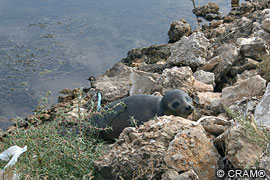 |
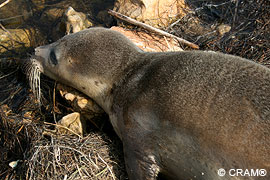 |
|
|
|
|
The postmortem revealed that the seal was a young female weighing 15 kg and measuring 95 cm in length. It showed a serious intestinal impaction in the cecum, 26 cm long, fibrinous enteritis, a serious parasitism by nematodes in the stomach that produced a diffused gastritis and lung collapse. Further microbiology and histopathology exams are currently being carried out by experts in these subjects.
The common seal (Phoca vitulina) lives in Arctic and subarctic waters of the Pacific and Atlantic seas; its presence in the Mediterranean is highly unusual.
Recognising the exceptional nature of this event, further investigations are currently being carried out in order to discover the causes by which the seal could travel to this latitude. It is unknown how a female that has not yet reached the adult state could be found in Catalonian waters. – Beatriz González Melcón, Veterinary Surgeon, CRAM Foundation.
In an attempt to gain a wider view on the distribution of monk seals and their habitat, the Middle East Technical University Institute of Marine Sciences surveys a new area each year. By now, almost all the seal caves on the coast of Northern Cyprus and the coast between Mersin and the Turkish/Syrian border have been discovered. In 2008, with a grant from TUBITAK (Scientific and Technological Research Council of Turkey), the surveyed area was expanded to Antalya (see Survey in Antalya, below). Antalya represents the core of tourism in Turkey; nine million tourists visited Antalya in 2008. The majority are hosted at beach resorts, although the rocky coast has remained rather intact since a significant part of it is included in the Olympos-Beydaglari National Park. Also, part of the national park is banned for divers. On the other hand, there is no limitation for boat owners organizing daily trips to the coast of the park.
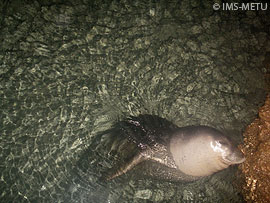 |
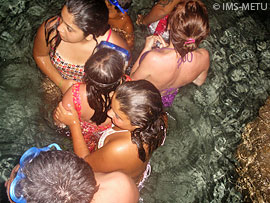 |
|
|
A monk seal captured by automatic camera in a cave in the Olympos-Beydaglari National Park. |
The same camera captures 7 tourists in the same National Park cave. |
Three surveys were conducted along this impressive coast; in June, August and November respectively. A total of eight caves were considered suitable and monitored with photo-traps. During the first two surveys (but particularly in August) many boats were sighted very near to the caves used by the seals. Moreover on several occasions, the team met people inside those caves with open and easy access. Most shocking and frightening of all, however, are the photographs taken automatically in one of the caves. It is shocking because the photographs were taken in the very small air chamber (not more than 4m2), located at the distant end of a cave with a very narrow and long entrance. Seven people of varying age may be seen on the photographs. It is frightening since the cave is still used by the seals; two seals were identified in the cave. The data collected indicated that the number of visits by tourists is by far greater than the visits by seals. Luckily, or intentionally, the seals use the cave at night. However, it doesn’t seem so likely that seal and tourists will partition the cave in such a manner for long. It is more probable that the very few seals still inhabiting the area will eventually abandon the national park, as in many other sad examples occurring elsewhere in the Mediterranean. – Ali Cemal Gücü, METU-IMS.
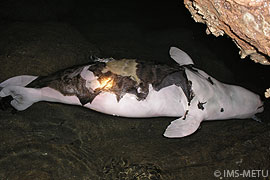
The whelping season starts in early autumn in the northeastern Mediterranean and lasts until mid-winter. The conservation team of Middle East Technical University Institute of Marine Sciences visits all recorded seal caves on the Cilician coast in order to assess the reproductive success of the colony in each breeding season. The team has observed that whelping occurs in 8 particular caves of the area, each having almost identical features; a large platform, an inner pool and a narrow entrance protecting the inner part against high waves. Apart from breeding caves, the team has observed seals while resting in several other caves, some of which are frequently used throughout the year.
On 6 November 2008, a pup was found dead in one of these caves that had never previously been used for whelping. The cave has several but very narrow platforms which are not large enough for breeding. The pup was still in the inner part of the cave floating on the water. Although the carcass was badly decomposed it was possible to see the umbilical cord still attached to the body, indicating that the pup is not older than a week.
Competition for breeding habitat among females has never been observed in the past. Moreover, two different mothers gave birth in the same cave (one month apart) in 2005 and 2006. Just why the mother gave birth to her pup in such an unfavorable cave, while a suitable one was just a few nautical miles away, remains an important, unanswered question. – Ali Cemal Gücü, METU-IMS.
The current distribution of the Mediterranean monk seal population in the Mediterranean is becoming clearer with recent studies. The coast of Antalya, despite being acknowledged as important monk seal habitat, has never been studied systematically. On the other hand, signs of a possible seal presence in the region were suggested by coastal topography and the frequency of recent monk seal sighting reports.
Western Antalya, with its small islands and rocky cliff-bound coast, appeared to be the most favourable area, including cape Gelidonya where human disturbance appears minimal. Three surveys were carried out between June and November 2008. The research team was composed of 6 people – 5 scientists from Middle East Technical University Institute of Marine Sciences, and a volunteer. During the first phase of the study, the entire coastline between Kemer and Finike was surveyed. Forty-one caves were discovered, both along mainland and island coasts. Of these, only 8 were considered suitable for seal use.
The second phase was the installation of automatic cameras and infrared monitors, with a total of 11 being installed in those 8 caves. The third phase was to retrieve the cameras and recorded digital images, and reinstall. More than 200 seal photographs were collected from 3 caves; these were used for seal identification purposes. All the markings visible on the photographs were plotted on scar-charts and 4 individual seals were identified. A GIS inventory was created with the results of surveys.
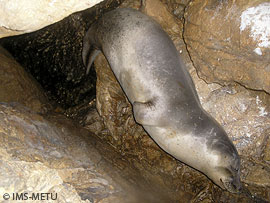 |
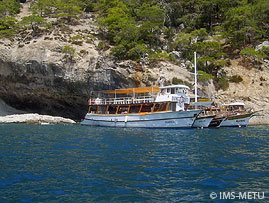 |
|
|
A monk seal resting in an island cave near Olympos. |
Tour boats around a seal cave near Olympos this summer. |
Human disturbance was observed to be very high throughout the monk seal habitats, and the most serious pressure appeared to be the human intruders who were even observed in the caves, captured by the installed cameras and infrared monitors [see Tourists captured on seal monitors, above]. The results of this study are not only important for conservation planning within the studied region, but also for improving our understanding of the seal population, as well as seal interaction and habitat use throughout the Turkish areas of the Mediterranean. – Serdar Sakinan, METU-IMS.
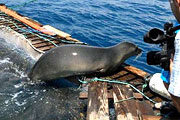 |
|
|
From Hürriyet’s |
With the 2008 tourist season on the wane and beachgoers diminishing, monk seal ‘Badem’ was released from her temporary captivity in September.
The rescued seal had been taken into protective care in early July, both for her own safety and that of bathers, with whom she was increasingly interacting [see Ambassador with attitude, TMG 11(1): June 2008; Badem under armed guard, Latest News, June 2008; and Badem in ‘protective custody’, Latest News, 2 August 2008.]
The move followed several injuries that the playful or deliberately provoked seal inflicted upon swimmers, and concerns by tourist enterprises and local government that her antics might ultimately drive away tourists rather than attract them.
Rescued in December 2006 as an orphaned pup, Badem underwent rehabilitation in Foça with expertise provided by the Zeehondencrèche Lenie ‘t Hart of the Netherlands, but became imprinted on her human carers during the 5-month process.
Despite ups and downs since her original rescue and release, Badem has become a powerful ambassador for her species among the Turkish public, appearing in numerous newspapers and television reports. Paradoxically, however, the attention has also served to exacerbate rather than diminish her longing for human contact.
Turkish NGO SAD-AFAG, that coordinated Badem’s rehabilitation, had earlier voiced the hope that the young seal, once separated from humans within a customized 2500m2 fish farm enclosure, might regain a more natural seal-like behaviour.
Recent press reports, however, suggest that following her release Badem quickly returned to her old, fun-loving ways, frolicking with late-season bathers.
The organizations responsible have yet to release their detailed assessment and scientific findings of the rehabilitation and release procedures applied in Badem’s case. There can be no doubt that assessments of this kind can prove invaluable aids to other monk seal rehabilitation efforts, the science of which remains poorly understood. For monk seal pups brought into rehabilitation, survival is by no means a foregone conclusion; a substantial number die during the process. Information remains a vital key in improving rescue and rehabilitation techniques, and may even end up saving the lives of future orphans.
Hürriyet. Badem Photo Gallery.
Hürriyet. Fok Badem'e denizde yuva, 6 July 2008.
NTV/MSNBC. Fok Badem koruma altında, 7 July 2008.
Hürriyet. 2500 m2’lik özel havuzda, 14 July 2008.
Hürriyet. Fok Badem'in keyfi yerinde, 18 July 2008.
The Didymian. Badem meets visitors in a new pool. 26 July 2008.
YouTube. Killer Seal. "Killer seal" at Defnelli Bay, October 2008.
Seal is enjoying a taste of freedom
Badem, who is being looked after courtesy of one of Turkey’s richest businessman, Mustafa Koç was released from the pool in Marmaris. It was kept in a pool to preserve its natural instincts and not to get close to people. But on her release, Badem went straight to Akyaka beach to play with people.
Badem was found in sea off Didim on December 5th, 2006 with injuries to her body. The Turkish Underwater Research Group (SAD-AFAG) kept Badem in the Mediterranean Seal Rehabilitation Centre in Izmir’s Foca city for 5 months. Badem was kept under control and rehabilitated by top veterinarians and sea biologists from Lenie 't Hart Zeehondencreche and Turkish Underwater Research Group during this 5 month period.
After the rehabilitation period, Mustafa Koc sponsored Badem by donating all the costs associated with looking after the seal.
In 2007 Badem went to the Gokova Gulf and started to interact with people. SAD-AFAG, who is monitoring the seal, took it to a pool in Marmaris to stop its contact with people. It was released from the pool at the end of September as it was hoped that it wouldn’t interact with people again. But Badem went straight to the beach where it was previously playing with people.
The seal is now surviving by itself following the fishing boats and passing the time by playing with people.
Source: Seal is enjoying a taste of freedom, The Didymian, 18 October 2008.
In May 2008, the Environment Protection Agency for Special Areas (EPASA) nominated SAD-AFAG to carry out two research and analysis projects in the Foça Special Environment Protection Area: Marine Vessel Carrying Capacity of Foça SEPA and Monitoring of the Mediterranean Monk Seal and its Habitat in Foça SEPA.
The Foça Carrying Capacity project was launched in early June 2008 and will last 7 months after the protocol signature. EPASA aims to identify carrying capacity of marine vessels in the coastal SEPAs in Turkey, and the Agency has already completed the first research and analysis project in this field in Göcek SEPA in Fethiye Bay last year. Foça will be the second SEPA and fishing vessels, both industrial and artisanal, will constitute the main target group in the research and analysis. Both ecological and maritime transport subjects will be analyzed in parallel. First, the importance and potential of biological diversity will be studied and reported, with special emphasis on endangered marine and coastal species in the Foça SEPA. Second, the total number of boats, maritime traffic, anchorage areas, discharges from ships, ports and piers will be analysed by SAD-AFAG in order to ensure optimum shipping activities in Foça, ultimately aiming to minimize the harmful impacts of maritime traffic upon the ecological assets of the Foça SEPA and vicinity.
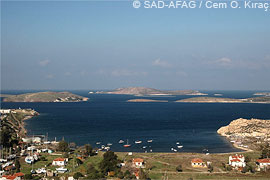 |
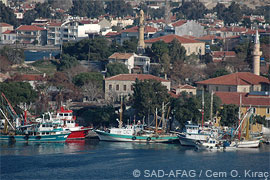 |
|
|
Foça marine protected area and islands from the southern hills. |
Purse-seiners in Büyük Liman port in Foça. |
The aim of the second research and analysis project is to identify specifically the current status of the Mediterranean monk seal and its habitat in the Foça protected area, initiated following a protocol between EPASA and SAD that was concluded on 28 May 2008. Although the quality of habitat has not changed in years, the frequency of monk seal sightings in the Foça SEPA has been reduced since 2004, while no breeding has occured since 1996. Therefore, this project also aims at identifying the factors negatively affecting the monk seals in the area, and to provide an assessment and proposals for remedial action by the responsible official bodies. The project will reflect the updated status of monk seals between 2004 and 2008. A book and a leaflet will also be designed and published in cooperation with EPASA and SAD-AFAG during the project period, and will be distributed to the main stakeholders and public, mainly in Foça.
Both projects will be completed by the end of 2008, and the results used by EPASA in Foça SEPA Management Planning for implementation in the near future. – Cem O. Kıraç, SAD-AFAG.
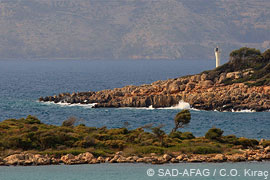
Sedir Island (with lighthouse) and northern Gökova coasts (background).
SAD-AFAG and the Netherlands-based Rubicon Foundation have developed a joint project entitled Putting PEEN (Pan-European Ecological Network) to Practice in Marine and Coastal Areas; a demonstration project ensuring the ecological resilience, coherence and sustainable future of Gokova Bay SEPA in Turkey. The project was approved by a jury headed by the Dutch Ministry of Agriculture. As project partners, the Environment Protection Agency for Special Areas (EPASA) and Ministry of Agriculture and Rural Affairs (MARA) of Turkey provided official backing, prior to project approval. Eurosite, a network of organizations managing Europe’s natural heritage, has also taken a partnership role. The project’s long-term target is to protect marine biodiversity in Turkey through effective national legislation and planning via national and local management mechanisms. The immediate objective is to achieve the conservation of Gökova Bay, in part through new national fishery legislation developed and tested within the framework of the sustainable management planning of Gökova Bay SEPA.
Ecological components, including fish, birds, marine mammals and posidonia, and socio-economic components, including tourism, marine traffic, and fisheries, will be studied individually. Pollution loads and sea water quality levels will also be analyzed. All the data will be input into a GIS database to be specially designed for this project.
The most important outcome will be integrated coastal and marine management planning (ICMM) for Gökova SEPA, based on the cumulative data incorporating various layers of human use (socio-economic conditions), threats, habitats and biological diversity. Since EPASA and MARA have already provided their official letter of intent to SAD-AFAG prior to the project, the cooperation and support from the relevant state departments are keenly anticipated. It is also expected that the EPASA will be putting the ICMM Plan into force after the completion ofthe project. – Cem O. Kıraç, SAD-AFAG.
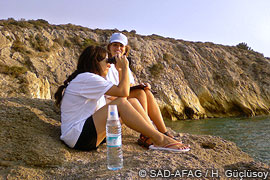
SAD-AFAG Foça science camp.
SAD-AFAG hosted one of three science camps between 4 and 31 August 2008. The camp was organized in the Foça SEPA, where SAD-AFAG has been carrying out monk seal conservation projects since 1993. The aim of the Science Camp is to train 3rd or 4th grade undergraduates or beginners of graduate school in the applied marine conservation sciences and management, in particular on monk seals, sea grass meadows and fish. The name of the camp was chosen as ’Prof. Dr. Bahtiye Mursaloğlu Foça Science Camp’ in honour of the first scientist to work on critically-endangered monk seals in Turkey. The camp comprised 4 weekly modules; two dedicated to monk seal surveys, conservation and management, one to Posidonia meadow habitat survey techniques, and the last to marine fish survey methods. Academic support was provided by the Institute of Marine Sciences and Technology of Dokuz Eylül University. Thirty-six students of Biology Departments or Aqua Product Faculties from 10 different Turkish cities participated. Twelve trainers were actively involved during the science camps. SAD-AFAG is planning to continue these camps on an annual basis. – Harun Güçlüsoy, SAD-AFAG Foça Office.
UNDP-GEF, in partnership with Turkey’s Environment Protection Agency for Special Areas (EPASA), is expected to embark upon a wide-ranging management project by 2009.
The project, known by its formal title as Strengthening the protected area network of Turkey: catalyzing sustainability of marine and coastal protected areas (MCPA), proposes innovative protected area management solutions.
The project objective is to facilitate expansion of the national system of marine and coastal protected areas and improve its management effectiveness. The project is for 5 years with a total budget of $6,530,000 (GEF grant $2.530.000, co-financing $4,000,000).
Expected outcomes are:
These components are likely to result in a full check-up for Turkey’s MCPAs: 9 Specially Protected Areas, 3 National Parks and 1 Ramsar Site, while also providing the opportunity for other coastal and marine protected areas (SEPAs) to be established by the MoEF and EPASA in consultation with relevant organizations experienced in their various fields.
Cem O. Kıraç, Harun Güclüsoy and N. Ozan Veryeri represented SAD-AFAG in the project’s inaugural meeting, held in Ankara in 4 September 2008, in which several other specialists from NGOs and universities, as well as governmental delegates, also participated.
SAD-AFAG representatives assumed tasks in three separate working groups relevant to their own work experience. They observed that their partners in the groups all showed strong motivation and know-how in this inter-disciplinary project.
Following the presentation and evaluation sections of the workshop, it seems that the UNDP and EPASA representatives are satisfied with the amount of original data produced in such a short period of study, and with the harmony of collaboration between independent actors.
The project proposal is expected to be submitted by the project team by November 2008 and GEF Agency approval is expected by April 2009. Implementation of the project may start by September 2009. – N. Ozan Veryeri, SAD-AFAG Karaburun Office.
EndQuoteDream Homes Antalya This world famous tourist region has the highest number of diving schools in the country, containing many contrasting dive sites. A French military transportation ship at the entrance of Antalya harbour lies at a depth of 20 - 32m. The islands in the open seas around Tekirova has [sic] a wonderful array of sea life including huge thornback rays, and is also a good location for cavern diving. During August and September there is a huge amount of tuna fish and seals, and dolphins can be seen throughout the year.
|
Copyright © 2008 The Monachus Guardian. All Rights Reserved |